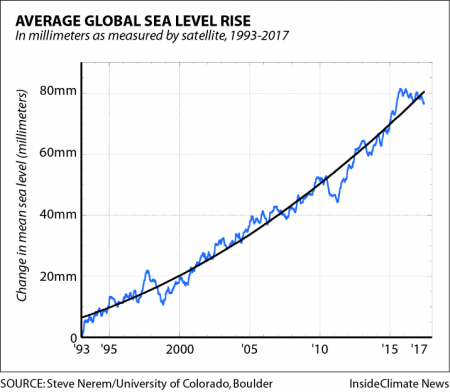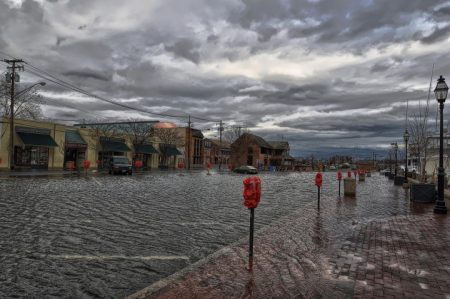February 19, 2018 – Reading satellite data can be downright depressing these days as we learn that our efforts to stem climate change and its byproducts are not following computer modeling scripts. Yesterday I wrote about atmospheric temperatures by mid-century exceeding the 2.0 Celsius Paris agreed to limit to help sustain the planet’s health and civilization as we know it. Today I’m writing about rates of sea level rise that Earth observation satellites are telling us are at an accelerating pace.
Just how fast are our ocean levels rising? It’s not uniform across the globe but some coastal cities will see as much as 10 centimeters (4 inches) per decade by century end. That number isn’t accounting for extreme weather leading to elevated storm surges that will do even greater damage to coastal infrastructure and freshwater aquifers.
Climate simulations had always predicted an acceleration throughout the century but not one at a pace of 10 centimeters a decade. But the findings published on February 12, 2018, in the Proceedings of the National Academy of Sciences, validate elevated acceleration rates largely because data voids have finally been filled in through the deployment of better ocean surface mapping across the entire planet. Satellite data paints a three-dimensional picture of our ocean including its bulges and dips with current rate of change accurately plotted to the millimeter. The graph below shows the acceleration from data analysis covering from 1993 to the present and there’s no denying the trend.

What does this mean for the bulk of humanity living close to Earth’s seacoasts? We have two choices. Build resilience in infrastructure to withstand the rising waters which includes dikes to hold the oceans back, and protection of freshwater aquifers from seawater inundation. Or plan to move entire populations away from threatened seacoasts. In either case the cost to combat sea level rise can be measured in trillions of dollars.
Why is the change accelerating? Two reasons. The oceans are getting warmer causing them to expand. The melting of polar sea and land ice is adding to ocean volume. Combined the two are heading us towards an ocean mean sea level rise of 0.61 meters (2 feet) by 2100.
Climate researchers describe the finding as a “game changer.” But for whom? The current U.S. administration doesn’t accept the science. Other countries have made little progress in addressing the causes of the warming that is contributing to sea level rise. This dereliction of leadership is unconscionable.















